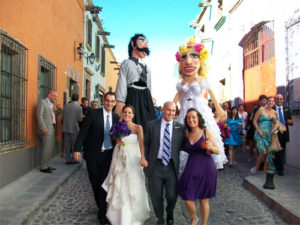Mojigangas of San Miguel
Place Category: Services
-
WE ARE THE MOJIGANGAS OF SAN MIGUEL…
WE ARE GIANT PUPPETS FOR RENT OR SALE!
 What is a mojiganga?
What is a mojiganga?A mojiganga (pronounced: mo-he-gang-ga) is a giant puppet also used as sculpture or a grand scale design element for a large event. The head and bust are made of papier mâché which is then mounted on a tall supporting A-frame structure. Our mojigangas range from approximately 6 to 18 feet tall (2-6 meters). The puppeteer is able to see out through an opening in the costuming at his/her eye level. The dancer/puppeteer climbs under the structure and then places a shoulder harness on to support the weight of the head/bust. The feet of the dancer become the feet of the Mojiganga. These puppets can be animated by the puppeteer through movement or can be free standing as larger-than-life decor or props.
The word “mojiganga” carries with it the meaning of “burlesque”… these giants, created by Hermes and Cindi, are farcical and expansive exaggerations of humanity. The artists also create portraiture and realistic style puppets in their body of work. Animal mojigangas are also a part of their body of work.
 What is the origin of The Mojiganga?
What is the origin of The Mojiganga?The Mojigangas of San Miguel de Allende, Mexico, trace their origin to the tradition of The Giants (Los Gigantes) of Spain. The Spaniards brought this tradition to Mexico and other parts of Latin America. The tradition took hold in some places and not others. San Miguel de Allende and Oaxaca are two locations where the tradition rooted and evolved to a different, more locally interpreted folk art form. The original Giant style was more apt to depict aristocratic figures that are symmetrical and more doll-like in appearance. In Latin America this tradition morphed into the more relaxed & burlesque art form seen in Las Mojigangas de San Miguel… A merging, at times, of the Sacred with the Profane. Spain continues with a strong tradition of The Giants in both their secular and religious culture. One example is their role in The Parade of the Giants during La Pamplonada.
Hermes Arroyo and Cindi Olsman, continue to observe the current tradition of the mojigangas of San Miguel. As artists and artisans they are dedicated to evolving the deep cultural, psychological and artistic impact these giants have in the world of interactive performance art and colossal public imagery.
-
-

